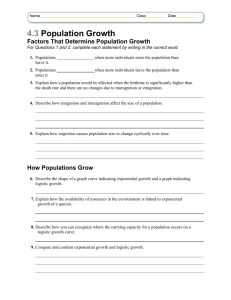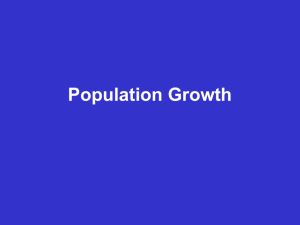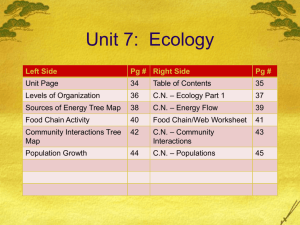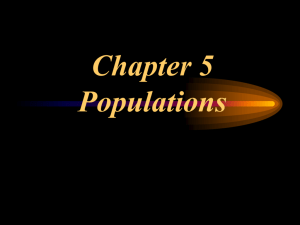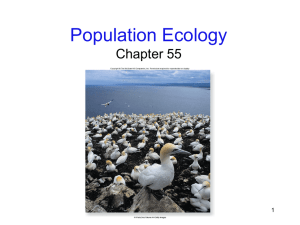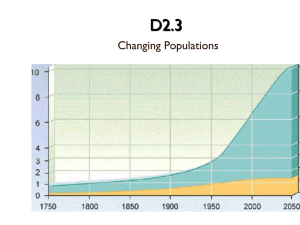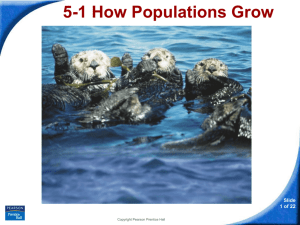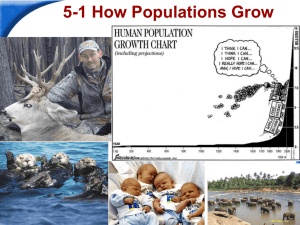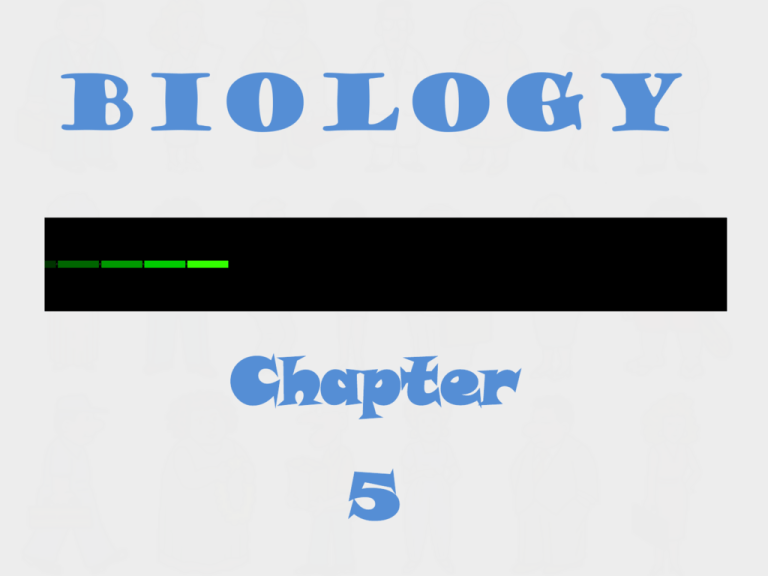
Biology
Chapter
5
Characteristics of Populations
• Geographic Distribution – the area inhabited by a
population
• Population Density – number of individuals per unit area
• Growth Rate – an increase or decrease of the number of
individuals in a population over time
Population Growth/Decline
• A population can grow when its birthrate is greater than its
death rate
• Immigration – movement of individuals into an area
• Populations can increase
• Animals maybe searching for mates or food
• Emigration – movement of individuals out of an area
• Populations can decrease
• Animals leave to find mates or food
• Exponential Growth
• Under ideal conditions with unlimited resources a
population will grow exponentially resulting in a
population explosion
• Exponential growth is characterized by a J-shaped
curve
• In nature exponential growth does not continue in a
population for very long
• As resources become less available, the growth of a
population slows or stops
Exponential Growth
Exponential Growth
Copyright Pearson Prentice Hall
• Logistic Growth
• Occurs when a population’s growth slows or stops
following a period of exponential growth
• Logistic growth is characterized by a S-shaped curve
initial carrying
capacity
new carrying
capacity
Copyright Pearson Prentice Hall
Fig. 46.6, p. 818
• What prevents the world from being overrun with all kinds
of living things?
• Carrying Capacity – the number of organisms of one
species that an environment can support
• When a population reaches the carrying capacity of
its environment, its growth levels off
Limiting Factors
• Limiting Factor – a factor that causes population growth
to decrease
• Density-Dependent Factors – a limiting factor that
depends on population size
• These factors operate most strongly when a
population is large and dense
• As populations increase so do these factors
• Example: competition, predation, parasitism, disease
• Density-Independent Factor – a limiting factor that
affects all populations regardless of the population size
• Example: natural disasters, storms, floods, drought,
pollution
• Demography – the study of human population growth
• For most of human existence, the population grew slowly
• Limiting factors kept population sizes low
• About 500 years age, the human population began growing
more rapidly
• Life was made easier and safer by advances in agriculture
and industry
• Death rates were dramatically reduced due to improved
sanitation, medicine, and healthcare, while birthrates
remained high
• With these advances, the human population experienced
exponential growth
Historical Overview
Human Population Growth
Copyright Pearson Prentice Hall
• Age Structure
• Age-Structure Diagrams – show the population of a
country broken down by gender and age group
• Population growth depends, in part, on how many
people of different ages make up a given population
• Demographers can predict future growth using agestructure diagrams
Patterns of Population Growth
Rapid
Slow
Zero
Negative
Growth
Growth
Growth
Growth
Copyright Pearson Prentice Hall
•
How can you tell if a population is growing?
•
If the birth rate is more than the death rate
• Does it make a difference to population growth if the
largest proportion of the population is in one age group?
• If a large percent of the population is teenagers and
children there is rapid growth
• If the percent of people in each category is equal the
population is stable



